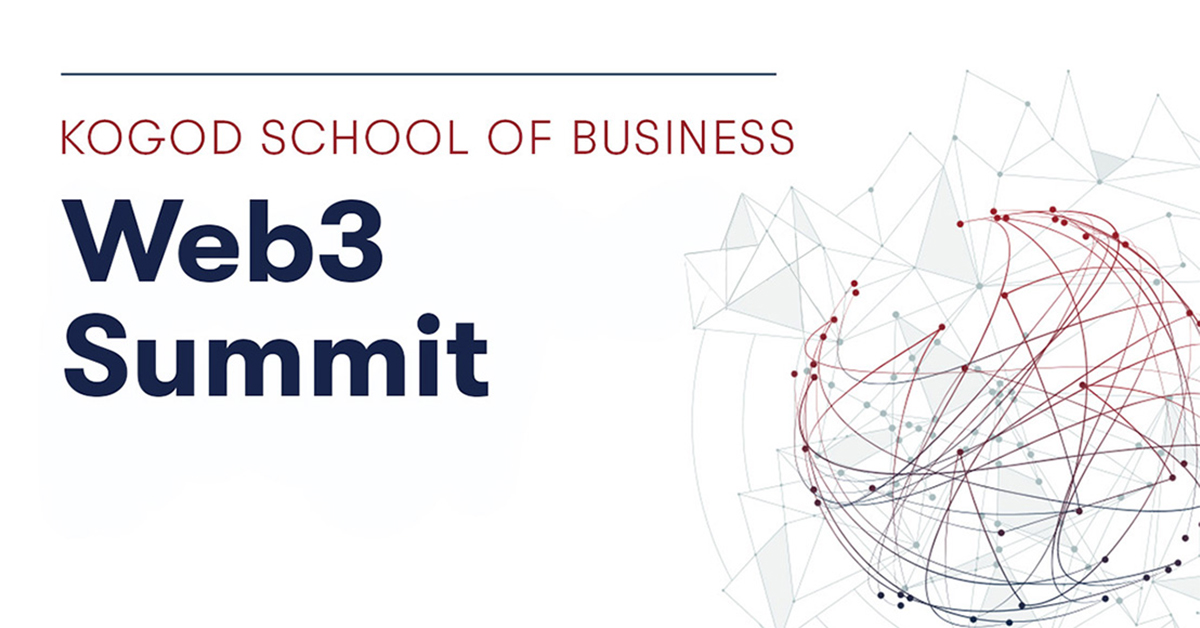
Darby Joyce
Content Marketing Coordinator
Cryptocurrency, digital assets, and uses for blockchain are making headlines, but have you heard the term Web3? What is Web3, how is it different from the current internet—or Web2—and what are Web3’s goals? The recent virtual Web3 summit, cohosted by the Kogod School of Business and the Global Blockchain Business Council, explored these questions and more. During the summit, experts in the blockchain space discussed their hopes for the future of this emerging technology.
In the words of keynote speaker Tomicah Tillemann, Web3 is a proposed next iteration of the internet focused on handing control of data back to individuals. Though the current internet, or Web2, enabled the advent of social media, Tillemann says it has since been commandeered by larger entities that limit the user’s control over how their data is used.
Web3’s stated aim is to promote transparency and privacy by decentralizing where user information is kept. However, as with all new technologies, the unknown factors make it challenging to meet these ideals—and Tillemann says it’s vital to meet them early in development.
Getting Web3 right isn’t just critical to the success of the Internet. It is also going to be fundamentally important to democracy itself.”
%20Fall%202022/TomicahTilleman.jpg)
Tomicah Tilleman
Chief Policy Officer, Haun Ventures
What does it mean to “get Web3 right?” For the first panelists, Caroline Hill and Kogod professor Bob Sicina, it entails striking a balance between digital accessibility and stability. Their discussion centered around Stablecoins, cryptocurrencies designed to maintain a set value and combat the notorious volatility of the crypto market.
Hill is the global policy and regulatory strategy director at Circle, the US Dollar Coin issuing company (USDC). The USDC maintains a one-to-one parity with the dollar by representing existing fiat money and making it usable in Web3. When the coin’s supply exceeds demand, Circle pulls excess currency out of rotation to keep the value stable. This leaves Circle’s users with a consistently valued currency that can be used in blockchain exchanges.
Hill mentioned that Circle’s userbase uses the USDC to pay international suppliers quickly without worrying about conversion rates or transfer times. “Circle was founded on the belief that money should be able to move at the speed of the internet,” Hill said. Wiring money often takes time and accumulates fees. Proponents of Stablecoin believe that Web3 can provide a more efficient experience.
The Stablecoin conversation continued during the second panel, which explained how Stablecoin differs from Central Bank Digital Currency (CBDC) and how nations are considering digitizing their money. Where Stablecoins are a separate currency altogether, CBDCs are a digital version of a country’s fiat currency and are regulated similarly. Many nations are exploring this option, and the United States is conducting preliminary research. Panelist Jennifer Lassiter, executive director of the Digital Dollar Project, hopes her work can contribute to an informed discussion of Web3 currency as a viable financial future for Americans.
“We’re here to ensure that we’re bringing to bear the resources of the private sector to create data so that decision-makers have the data they need to make decisions,” Lassiter explained.
The final decision on CBDC in the US would fall to the Federal Reserve. Cryptocurrency regulation has received bipartisan support, which did not surprise panelist Patrick Hansen of Presight Capital.
In general, there’s overwhelming support on both sides of the aisle not to kill innovation but to provide prudent guidelines.”
%20Fall%202022/PatrickHansen.jpg)
Patrick Hansen
Crypto Venture Advisor, Presight Capital
Innovation in Web3 currently covers a range of sectors. The event’s later panelists discussed how work in blockchain had enabled them to make economic and social strides. As the innovations and new initiatives lead for Heifer International, panelist Elizabeth Magombo-Kabaghe works predominantly with people who do not have access to standard banking options. She uses blockchain to connect farmers to previously inaccessible international markets.
“It’s tough for any entity to try and achieve our mission—preventing hunger and poverty,” Magombo-Kabaghe said. “This way of collaborating allows us to leverage on the work other like-minded organizations are doing.”
Web3 has also provided collaboration opportunities to remote workers. At the height of the COVID-19 pandemic, panelist David Treat’s company Accenture hosted culture-building and onboarding events through the metaverse, an immersive virtual reality platform.
“The metaverse is an implicitly collaborative environment,” he said. “Through extended reality, I can bring myself to this place and ask whom I can work with socially, commercially, politically. That’s a fundamentally different kind of digital world.”
The Kogod School of Business is at the forefront of emerging technology. Continue the Web3 conversation with us on September 14, when we host the in-person Web3 Summit. Join us at the forefront of an evolving conversation surrounding the innovative technology and its use cases!
